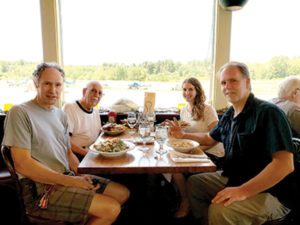By Barbara Allen, Contributing Writer
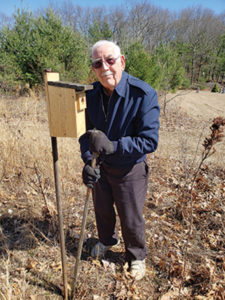
Maynard – In his 1964 album, “I Wish You Love,” Frank Sinatra croons, “I wish you bluebirds in the spring, to give your heart a song to sing…”
Ray Van Vorse, 91, has had that song in his heart for almost 60 years. In 1962, the Maynard resident learned from a Reader’s Digest article that the beautiful birds were on the verge of extinction. It kindled within him a desire to do whatever he could to help them.
One of the main reasons for the bluebirds’ near-demise, said Van Vorse, was the importation of the English house sparrow in the 1850s. Over the years, these newcomers increased in number and took over most of the natural nesting hole sites, often killing the original native hole nesters.
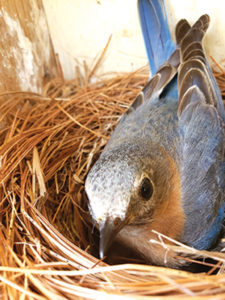
“It was discovered that nesting boxes [birdhouses] proved a perfect substitute and were readily accepted by bluebirds and other native hole nesters,” he explained. “By monitoring the boxes and evicting the interlopers, it was found bluebirds had a chance.”
Providing more bluebird-specific nesting boxes is key to their survival. Directions for making the nesting boxes are easy to find online, as are instructions for their proper placement. Bluebird-specific boxes can also be purchased ready-made in larger hardware, garden/bird stores and online.
But building or setting up the bluebird nesting boxes is only the beginning. Once in place, the boxes need to be maintained and monitored for damage by the elements or vandalism. Prior to each nesting season (March and June), they need to be cleared of old nesting material (which can harbor parasites harmful to the bluebird) and the insides sprayed with a mixture of bleach and water. English house sparrows will still attempt to oust bluebirds from their residence and build their own nests in the birdhouse. These should be removed when discovered. Birdhouses also need to be repaired or replaced before the onset of cold weather. Although bluebirds typically start “househunting” in March, they will sometimes linger through the winter, especially if fed dried mealworms.
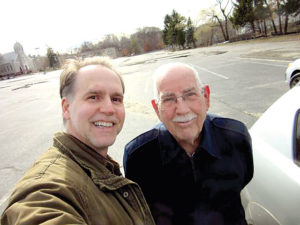
Van Vorse used to keep an old metal pan outside his kitchen window for just that purpose. Once the mealworms had been placed in the pan, he would “whistle like a chickadee,” and nearby bluebirds, recognizing his “call to dinner,” would flock to the pan to gobble up their treat. He has since replaced the pan with a special mealworm feeder, but still “whistles the bluebirds in,” although he admitted that his whistle “is now a bit more feeble.”
Over the years, Van Vorse alone maintained and monitored not only several bluebird nesting boxes in his own yard, but 45 others as well, in different locations in nearby towns. About six years ago, however, he found himself unable to keep up with the birdhouse management and put out the word that he needed help. Stow resident John Calabria was the first to come forward to offer his assistance, starting immediately by repairing and restoring some of the birdhouses that were in the worst shape.
“He has done more than I can ever thank him for,” said Van Vorse.
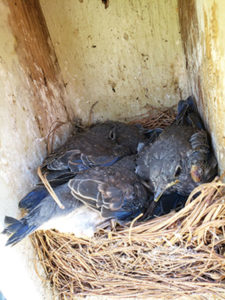
“What I appreciate about working with Ray over the years is the return to a simpler, and slower time,” noted Calabria. “Visiting with him, talking with him – time slows down. We are kindred spirits in our [observation of] all the unfoldings in nature.”
“Spending time with Ray honors our elders, honors the mentor-apprenticeship relationship,” he continued. “It keeps him in the game and allows him to share his countless of hours of mastery…”
Two additional helpers, Mark Higgins and Stephanie Stratigos, have since joined Van Vorse and Calabria in their mission. The “Bluebird Four,” as they refer to themselves, together now manage 65 nesting boxes on their “Bluebird Trails.”
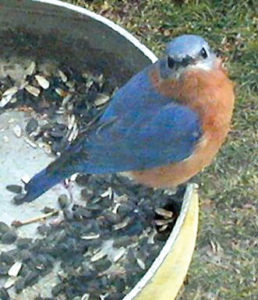
But more help is always needed.
“We hope many others will take up saving bluebirds in their area as well,” said Van Vorse. “It’s great exercise to get out, take care of these boxes and at the same time save a beautiful native bird badly in need of help.”
For information on how to help Van Vorse and the Bluebird Four, email Van Vorse at 25bloo_brd@toast.net or Calabria at eganvay@gmail.com. To learn more about saving the bluebirds in your own area, Google “Building your own bluebird boxes,” and “Starting a Bluebird Trail.”
Photos/submitted
